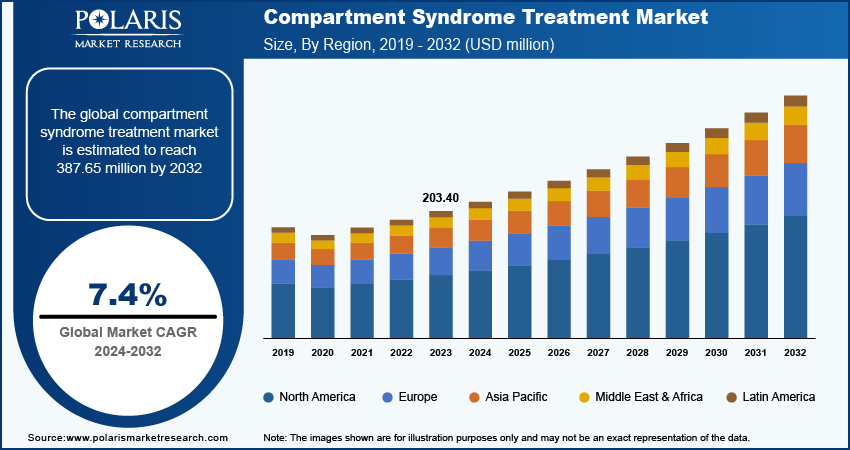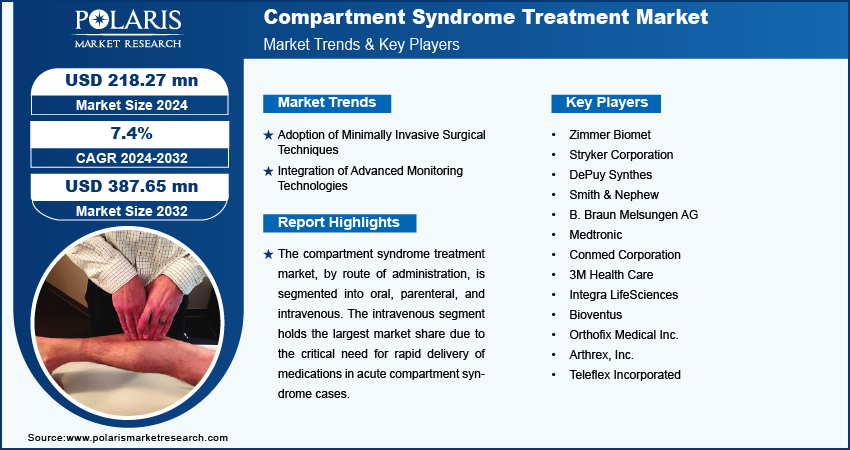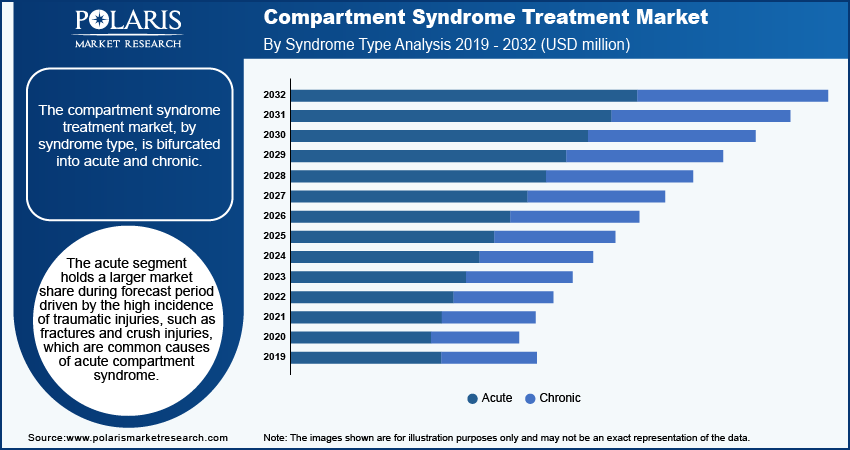
Compartment Syndrome Treatment Market Size, Share, Trends, Industry Analysis Report: By Syndrome Type (Acute and Chronic), Treatment Type, Route of Administration, Distribution Channel, and Region (North America, Europe, Asia Pacific, Latin America, and Middle East & Africa) – Market Forecast, 2024–2032
- Published Date:Oct-2024
- Pages: 118
- Format: PDF
- Report ID: PM5084
- Base Year: 2023
- Historical Data: 2019-2022
Compartment Syndrome Treatment Market Overview
The global compartment syndrome treatment market size was valued at USD 203.40 million in 2023. The market is projected to grow from USD 218.27 million in 2024 to USD 387.65 million by 2032, exhibiting a CAGR of 7.4% during 2024–2032.
The global compartment syndrome treatment market encompasses medical interventions, devices, and pharmaceutical products designed to manage and treat compartment syndrome, a serious condition resulting from increased pressure within a muscle compartment. The market growth is driven by the rising incidence of traumatic injuries, such as fractures and crush injuries, that increase the risk of compartment syndrome. Additionally, advancements in surgical techniques, development of innovative devices, and the increasing awareness among healthcare professionals about early diagnosis and treatment contribute to market growth. The adoption of minimally invasive surgical methods and the integration of advanced monitoring technologies to enhance patient outcomes are expected to emerge as key future trends in the market.

To Understand More About this Research: Request a Free Sample Report
Compartment Syndrome Treatment Market Drivers and Trends
Adoption of Minimally Invasive Surgical Techniques
A major future trend in the compartment syndrome treatment market would be the increasing adoption of minimally invasive surgical techniques. Traditional fasciotomy, the primary treatment for compartment syndrome, involves making large incisions to relieve pressure, which can result in significant scarring and a prolonged recovery period. Recent advancements in surgical technology have led to the development of less invasive procedures that achieve the same clinical outcomes with reduced tissue damage and faster recovery times. Surgeons are increasingly utilizing techniques such as endoscopic-assisted fasciotomy, which offer the benefits of minimal scarring and reduced postoperative complications. This shift toward minimally invasive approaches is driven by the growing demand for procedures that enhance patient comfort and accelerate healing.
Integration of Advanced Monitoring Technologies
There is a rising requirement for the integration of advanced monitoring technologies in the management of compartment syndrome. Accurate and timely diagnosis is crucial for preventing long-term complications, and recent technological advancements are improving the precision of intracompartmental pressure measurements. Portable and wireless pressure monitoring devices are being increasingly used in clinical settings, allowing for continuous and real-time monitoring of compartment pressures. This enables early detection of compartment syndrome, facilitating timely intervention and reducing the risk of permanent damage. According to a study published in the Journal of Orthopaedic Trauma, real-time monitoring has been shown to improve patient outcomes by enabling precise and timely treatment decisions. Therefore, the integration of advanced monitoring technologies is expected to propel the compartment syndrome treatment market during the forecast period.
Growing Awareness and Training Among Healthcare Professionals
In recent years, there has been a concerted effort to enhance the knowledge and skills of healthcare providers in identifying the early signs of compartment syndrome. This is particularly important in emergency and trauma care settings, where timely recognition can be lifesaving. Medical institutions and professional organizations are increasingly offering specialized training programs and workshops focused on the management of compartment syndrome. This trend is supported by initiatives aimed at improving the standard of care and reducing the incidence of delayed diagnosis, which has historically been a significant challenge in the management of this condition. The emphasis on education and training is expected to improve treatment outcomes and reduce complications associated with compartment syndrome. Hence, the growing awareness and training among healthcare professionals regarding the diagnosis and treatment of compartment syndrome is another key trend expected to emerge in the market during the forecast period.

Compartment Syndrome Treatment Market – Segment Insights
Compartment Syndrome Treatment Market Breakdown – Syndrome Type-Based Insights
The compartment syndrome treatment market, by syndrome type, is bifurcated into acute and chronic. The acute segment holds a larger market share during forecast period. Acute compartment syndrome is a medical emergency that requires immediate intervention to prevent irreversible muscle and nerve damage. Due to its severity and the urgency associated with treatment, this segment dominates the market, driven by the high incidence of traumatic injuries, such as fractures and crush injuries, which are common causes of acute compartment syndrome. The rising demand for rapid diagnostic tools and effective surgical interventions, particularly in emergency care settings, supports the growth of this segment.
The chronic compartment syndrome segment is registering a higher growth rate in the market. Chronic compartment syndrome is mostly observed in athletes and individuals engaged in repetitive physical activities, leading to increased awareness and diagnosis in sports medicine. The rising focus on non-invasive treatment options, including physical therapy and activity modification, and advancements in minimally invasive surgical procedures contribute to the expansion of this segment. Additionally, the growing emphasis on preventive care and the management of chronic conditions in sports and orthopedic practices drives the demand for specialized treatments in this category.
Compartment Syndrome Treatment Market Breakdown – Treatment Type-Based Insights
The compartment syndrome treatment market, based on treatment type, is segmented into surgery, supportive treatment, anti-inflammatory medications, and physiotherapy. The surgery segment holds the largest market share, as surgery, specifically fasciotomy, is the primary and most effective treatment for acute compartment syndrome. Considering the urgent nature of this condition, surgery is often the first-line intervention to prevent permanent damage to muscles and nerves. The high incidence of acute cases requiring immediate surgical intervention and the critical need for timely treatment drive the dominance of this segment in the market.
The physiotherapy segment is registering the highest growth rate, particularly in the management of chronic compartment syndrome. As nonsurgical approaches gain traction for chronic cases, physiotherapy is increasingly recognized for its role in rehabilitation and long-term management. Patients affected by chronic compartment syndrome, often athletes, benefit from tailored physiotherapy programs designed to alleviate symptoms and improve function without invasive procedures. The rising awareness of the benefits of physiotherapy in managing chronic conditions and its growing integration into multidisciplinary treatment plans are key factors contributing to the rapid growth of this segment.
Compartment Syndrome Treatment Market Breakdown – Route of Administration-Based Insights
The compartment syndrome treatment market, by route of administration, is segmented into oral, parenteral, and intravenous. The intravenous segment holds the largest market share due to the critical need for rapid delivery of medications in acute compartment syndrome cases. Intravenous administration is often used to deliver anti-inflammatory drugs and fluids in emergency settings for pain relief, providing quick therapeutic effects that are essential in managing acute conditions. The increasing preference for intravenous administration in hospital settings, where acute cases are most commonly treated, supports the dominance of this segment.
The parenteral segment, encompassing intramuscular and subcutaneous injections, is registering the highest growth rate. This growth is driven by the increasing use of parenteral administration for delivering medications in chronic compartment syndrome, where long-term management often requires consistent therapeutic intervention. Parenteral routes are favored for their ability to bypass the gastrointestinal tract, ensuring faster and more controlled absorption of drugs. The rising adoption of this route for supportive treatments and its expanding application in acute and chronic cases contribute to the segment's rapid growth in the market.
Compartment Syndrome Treatment Market Breakdown – Distribution Channel-Based Insights
The compartment syndrome treatment market, based on distribution channel, is segmented into hospital pharmacies, retail pharmacies, online pharmacies, and others. The hospital pharmacies segment holds the largest market share, driven by the critical nature of compartment syndrome, particularly acute cases that require immediate medical intervention. Hospital pharmacies are the primary source for the medications and supplies used in surgical and emergency treatments, ensuring that necessary drugs and equipment are readily available in settings where urgent care is provided. The reliance on hospital pharmacies for immediate access to life-saving treatments underpins their dominance in the market.
The online pharmacies segment is registering the highest growth rate, reflecting the increasing shift toward digital health solutions and the convenience of purchasing medications online. As patients and healthcare providers increasingly turn to online platforms for the procurement of drugs, particularly for chronic management and supportive treatments, this segment is experiencing rapid expansion. The growing availability of prescription medications through online channels, combined with the ease of access, competitive pricing, and the rise of telemedicine, is contributing to the robust growth of the compartment syndrome treatment market for the online pharmacies segment.

Compartment Syndrome Treatment Market – Regional Insights
By region, the study provides market insights into North America, Europe, Asia Pacific, Latin America, and the Middle East & Africa. In the regional analysis of the compartment syndrome treatment market, North America holds the largest share, primarily due to its advanced healthcare infrastructure, high incidence of trauma-related injuries, and widespread awareness of compartment syndrome among healthcare professionals. The region's strong focus on research and development, along with the availability of cutting-edge surgical techniques and advanced monitoring technologies, further drives market dominance. Additionally, the presence of key market players and the high adoption rate of new treatment methods in the US and Canada contribute significantly to North America's leading position in the global market.
The compartment syndrome treatment market in Europe is characterized by well-established healthcare systems and a strong emphasis on patient safety and quality of care. Countries such as Germany, the UK, and France lead the market due to their advanced medical facilities and high standards of trauma care. The region benefits from widespread awareness of compartment syndrome among healthcare providers, along with significant investments in medical research and innovation. Additionally, the growing geriatric population and the rising prevalence of chronic conditions contribute to the demand for acute and chronic compartment syndrome treatments. Europe is also witnessing a gradual increase in the preference for minimally invasive surgical techniques, further supporting the regional market growth.
The Asia Pacific compartment syndrome treatment market is experiencing rapid growth, driven by an expanding healthcare infrastructure and increasing healthcare expenditure in countries such as China, India, and Japan. The rising incidence of road accidents, sports injuries, and other trauma-related conditions in the region contributes to the growing demand for compartment syndrome treatments. Moreover, the increasing awareness of the condition, coupled with the availability of advanced medical technologies, is boosting market growth. The regional market also benefits from a large patient population and the rising prevalence of chronic diseases, which drive the demand for long-term management and treatment options for compartment syndrome. As healthcare systems in Asia Pacific continue to modernize, the market is expected to witness sustained growth in the coming years.

Compartment Syndrome Treatment Market – Key Players and Competitive Insights
Zimmer Biomet; Stryker Corporation; DePuy Synthes (a subsidiary of Johnson & Johnson); Smith & Nephew; B. Braun Melsungen AG; Medtronic; Conmed Corporation; 3M Health Care; Integra LifeSciences; Acelity (now part of 3M); Bioventus; Wright Medical Group (now part of Stryker); Orthofix Medical Inc.; Arthrex, Inc.; and Teleflex Incorporated are among the key players in the compartment syndrome treatment market. These companies are actively involved in the development, manufacturing, and distribution of medical devices, surgical instruments, and pharmaceuticals used in the treatment of compartment syndrome.
The market is characterized by strong competition among these companies, particularly in the areas of surgical devices and advanced monitoring technologies. Companies such as Zimmer Biomet and Stryker Corporation are well-established in the market and offering a wide range of products used in acute and chronic compartment syndrome treatments. Medtronic and Smith & Nephew are also key competitors known for their innovative approaches to surgery and post-operative care. The focus on improving surgical outcomes, reducing recovery times, and enhancing patient safety has led these companies to invest heavily in research and development. As a result, there is a continuous stream of product innovations and improvements, which intensifies the competition.
Companies such as 3M Health Care and Integra LifeSciences have strengthened their positions by offering comprehensive solutions that cover various aspects of compartment syndrome treatment, from wound care to surgical support. The competitive landscape is further influenced by strategic acquisitions and collaborations, with companies aiming to expand their product portfolios and geographic reach. Acelity, now part of 3M, has leveraged its expertise in wound care to enhance its market presence. Overall, the competition is driven by the pursuit of technological advancements, product differentiation, and the ability to meet the evolving needs of healthcare providers and patients.
Zimmer Biomet is a global player in the compartment syndrome treatment market, known for its extensive range of orthopedic and surgical products. The company specializes in developing medical devices used in the treatment of musculoskeletal conditions, including those associated with compartment syndrome. Zimmer Biomet's focus on innovation and improving patient outcomes has positioned it as a key provider of surgical instruments and implants.
Stryker Corporation is another major player in the market, offering a wide array of medical technologies, including surgical devices, instruments, and healthcare solutions relevant to the treatment of compartment syndrome. The company has a strong presence in trauma and extremities care, providing solutions that support acute and chronic conditions. Stryker is known for its commitment to advance surgical techniques and improve the overall standard of care.
Key Companies in Compartment Syndrome Treatment Market
- Zimmer Biomet
- Stryker Corporation
- DePuy Synthes (a subsidiary of Johnson & Johnson)
- Smith & Nephew
- B. Braun Melsungen AG
- Medtronic
- Conmed Corporation
- 3M Health Care
- Integra LifeSciences
- Bioventus
- Orthofix Medical Inc.
- Arthrex, Inc.
- Teleflex Incorporated
Compartment Syndrome Treatment Industry Developments
- In July 2023, Zimmer Biomet announced the launch of its latest surgical robotics platform, which aims to enhance precision in orthopedic surgeries, further strengthening its position in the market.
- In February 2023, Stryker announced the acquisition of a MOLLI Surgical (medical software company) focused on enhancing surgical navigation systems, which is expected to bolster its capabilities in precise surgical interventions.
Compartment Syndrome Treatment Market Segmentation
By Syndrome Type Outlook
- Acute
- Chronic
By Treatment Type Outlook
- Surgery
- Supportive Treatment
- Anti-Inflammatory Medications
- Physiotherapy
By Route of Administration Outlook
- Oral
- Parenteral
- Intravenous
By Distribution Channel Outlook
- Hospital Pharmacies
- Retail Pharmacies
- Online Pharmacies
- Others
By Regional Outlook
- North America
- US
- Canada
- Europe
- Germany
- France
- UK
- Italy
- Spain
- Netherlands
- Russia
- Rest of Europe
- Asia Pacific
- China
- Japan
- India
- Malaysia
- South Korea
- Indonesia
- Australia
- Vietnam
- Rest of Asia Pacific
- Middle East & Africa
- Saudi Arabia
- UAE
- Israel
- South Africa
- Rest of Middle East & Africa
- Latin America
- Mexico
- Brazil
- Argentina
- Rest of Latin America
Compartment Syndrome Treatment Market Report Scope
|
Report Attributes |
Details |
|
Market Size Value in 2023 |
USD 203.40 million |
|
Market Size Value in 2024 |
USD 218.27 million |
|
Revenue Forecast by 2032 |
USD 387.65 million |
|
CAGR |
7.4% from 2024 to 2032 |
|
Base Year |
2023 |
|
Historical Data |
2019–2022 |
|
Forecast Period |
2024–2032 |
|
Quantitative Units |
Revenue in USD million and CAGR from 2024 to 2032 |
|
Report Coverage |
Revenue Forecast, Market Competitive Landscape, Growth Factors, and Trends |
|
Segments Covered |
|
|
Regional Scope |
|
|
Competitive Landscape |
|
|
Report Format |
|
|
Customization |
Report customization as per your requirements with respect to countries, regions, and segmentation. |
How is the report valuable for an organization?
Workflow/Innovation Strategy: The compartment syndrome treatment market has been segmented on the basis of syndrome type, treatment type, route of administration, and distribution channels. Moreover, the study provides the reader with a detailed understanding of the different segments at the global and regional levels.
Growth/Marketing Strategy: The growth and marketing strategy for the compartment syndrome treatment market focuses on expanding product offerings and enhancing technological capabilities. Companies are investing in research and development to introduce advanced surgical devices, minimally invasive techniques, and innovative monitoring technologies. Strategic partnerships and acquisitions are being pursued to broaden product portfolios and enter new geographic markets. Additionally, companies are increasing their outreach through educational programs for healthcare professionals to improve diagnosis and treatment practices. Emphasizing digital platforms and online channels for distribution and patient engagement is also becoming a key component of the strategy.
FAQ's
The global compartment syndrome treatment market size was valued at USD 203.40 million in 2023 and is projected to grow to USD 387.65 million by 2032.
The global market is projected to register a CAGR of 7.4% during 2024–2032
North America accounted for the largest share of the global market in 2023.
Key players in the compartment syndrome treatment market are Zimmer Biomet; Stryker Corporation; DePuy Synthes (a subsidiary of Johnson & Johnson); Smith & Nephew; B. Braun Melsungen AG; Medtronic; Conmed Corporation; 3M Health Care; Integra LifeSciences; Acelity (now part of 3M); Bioventus; Wright Medical Group (now part of Stryker); Orthofix Medical Inc.; Arthrex, Inc.; and Teleflex Incorporated.
The acute compartment syndrome segment accounted for a larger share of the global market.
The surgery segment accounted for the largest share of the global market.
Compartment syndrome is a serious condition caused by increased pressure within a muscle compartment, leading to reduced blood flow, nerve damage, and potential muscle loss. It often results from trauma, fractures, or overuse.
A few key trends in the compartment syndrome treatment market are described below: Adoption of Minimally Invasive Techniques: Increasing use of minimally invasive surgical methods, such as endoscopic-assisted fasciotomy, to reduce recovery time and improve patient outcomes. Integration of Advanced Monitoring Technologies: Growing use of real-time, portable pressure monitoring devices to enhance early diagnosis and timely intervention. Rising Awareness and Training: Enhanced focus on educating healthcare professionals about compartment syndrome for better early detection and management. Growth in Nonsurgical Treatments: Increased use of physiotherapy and other noninvasive methods for managing chronic compartment syndrome.
A new company entering the compartment syndrome treatment market must focus on developing and offering innovative solutions in minimally invasive surgical techniques and advanced monitoring technologies. Emphasizing research and development to create cutting-edge devices and tools for accurate and early diagnosis can differentiate the company. Additionally, investing in digital health solutions and online distribution channels can enhance accessibility and patient engagement. Building strategic partnerships with healthcare providers and offering comprehensive training programs for medical professionals can also establish a strong market presence and drive business growth.
Companies offering compartment syndrome treatment and related products, healthcare providers, and other consulting firms must buy the report.
